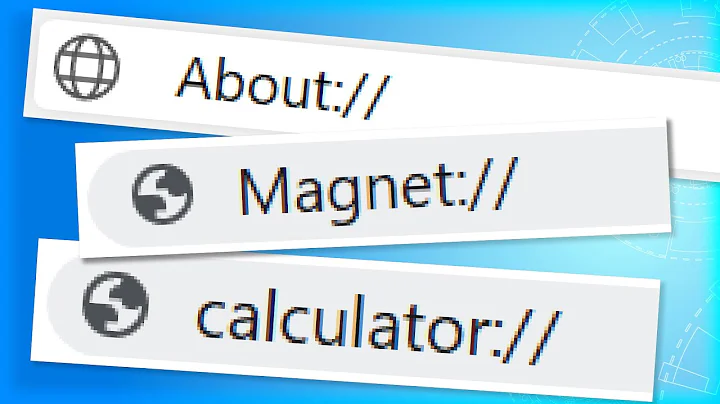How to implement my very own URI scheme on Android
Solution 1
This is very possible; you define the URI scheme in your AndroidManifest.xml, using the <data> element. You setup an intent filter with the <data> element filled out, and you'll be able to create your own scheme. (More on intent filters and intent resolution here.)
Here's a short example:
<activity android:name=".MyUriActivity">
<intent-filter>
<action android:name="android.intent.action.VIEW" />
<category android:name="android.intent.category.DEFAULT" />
<category android:name="android.intent.category.BROWSABLE" />
<data android:scheme="myapp" android:host="path" />
</intent-filter>
</activity>
As per how implicit intents work, you need to define at least one action and one category as well; here I picked VIEW as the action (though it could be anything), and made sure to add the DEFAULT category (as this is required for all implicit intents). Also notice how I added the category BROWSABLE - this is not necessary, but it will allow your URIs to be openable from the browser (a nifty feature).
Solution 2
Complementing the @DanielLew answer, to get the values of the parameteres you have to do this:
URI example: myapp://path/to/what/i/want?keyOne=valueOne&keyTwo=valueTwo
in your activity:
Intent intent = getIntent();
if (Intent.ACTION_VIEW.equals(intent.getAction())) {
Uri uri = intent.getData();
String valueOne = uri.getQueryParameter("keyOne");
String valueTwo = uri.getQueryParameter("keyTwo");
}
Solution 3
I strongly recommend that you not define your own scheme. This goes against the web standards for URI schemes, which attempts to rigidly control those names for good reason -- to avoid name conflicts between different entities. Once you put a link to your scheme on a web site, you have put that little name into entire the entire Internet's namespace, and should be following those standards.
If you just want to be able to have a link to your own app, I recommend you follow the approach I described here:
Solution 4
Another alternate approach to Diego's is to use a library:
https://github.com/airbnb/DeepLinkDispatch
You can easily declare the URIs you'd like to handle and the parameters you'd like to extract through annotations on the Activity, like:
@DeepLink("path/to/what/i/want")
public class SomeActivity extends Activity {
...
}
As a plus, the query parameters will also be passed along to the Activity as well.
Solution 5
As the question is asked years ago, and Android is evolved a lot on this URI scheme.
From original URI scheme, to deep link, and now Android App Links.
Android now recommends to use HTTP URLs, not define your own URI scheme. Because Android App Links use HTTP URLs that link to a website domain you own, so no other app can use your links. You can check the comparison of deep link and Android App links from here
Now you can easily add a URI scheme by using Android Studio option: Tools > App Links Assistant. Please refer the detail to Android document: https://developer.android.com/studio/write/app-link-indexing.html
Related videos on Youtube
punnie
Site Reliability Engineer with 10 years of experience in both Software Engineering and System Operations roles, owning a strong Software Engineering technical background and good business acumen. I've worked for companies such as the Fraunhofer Research Institute, Gruvi and Talkdesk, besides having done contract work for several international companies.
Updated on June 07, 2020Comments
-
punnie about 4 years
Say I want to define that an URI such as:
myapp://path/to/what/i/want?d=This%20is%20a%20testmust be handled by my own application, or service. Notice that the scheme is
"myapp"and not"http", or"ftp". That is precisely what I intend: to define my own URI schema globally for the Android OS. Is this possible?This is somewhat analogous to what some programs already do on, e.g., Windows systems, such as Skype (
skype://) or any torrent downloader program (torrent://).-
Casebash about 14 years
-
-
punnie over 14 yearsThanks for the heads up, but I'll be only using this to try to prove a concept, in a closed environment. Should this experiment ever leave its testing phase, I'll definitely consider ratifying the whole deal.
-
hackbod over 14 yearsOkay... but why not just do the right thing? It's not any significant more work.
-
Casebash about 14 yearsIt took me a while to figure out that to link to a specific path that the "android:path" variable has to specify everything after the protocol, ie. it must be of the form "youtube.com/myvideo"
-
AlikElzin-kilaka about 12 yearsYoutube do what @hackbod is suggesting, but opening Youtube links from facebook opens the browser and not the Youtube app. Is this mechanism too "delicate"?
-
 Timo Ernst about 11 yearsWorks great but how can I read the value of the GET parameter "d" given in the url from MyUriActivity?
Timo Ernst about 11 yearsWorks great but how can I read the value of the GET parameter "d" given in the url from MyUriActivity? -
Chicowitz over 10 yearsI'm leaning towards defining my own scheme so that I can use the same web logic to launch either my iOS app OR my Android app. Just my 2 cents
-
mohitum almost 10 yearsnot working for me I have multiple Intent filters for the same activity. One for main launcher. second for opening a particular file third as above First two are working perfectly but not the third.
-
 Salmaan over 9 yearscan you please look at the question here stackoverflow.com/q/29116574/3828908
Salmaan over 9 yearscan you please look at the question here stackoverflow.com/q/29116574/3828908 -
 Bugs Happen over 8 yearswhat if the link is like
Bugs Happen over 8 yearswhat if the link is likehttp://www.host.com/directory/value? How can we get thisvalue? -
 Bugs Happen over 8 yearsNever mind, got the SO answer here.
Bugs Happen over 8 yearsNever mind, got the SO answer here. -
Zensaburou over 8 yearsEnglish language version of the above link just in case someone needs it.
-
 Pradeep Chakravarti Gudipati about 7 yearsHow to read the data tags in AndroidManifest.xml in code without using meta data. I need that to send the exact scheme,path & host to the server also in the oauth call. I do not want to duplicate the call back declaration !
Pradeep Chakravarti Gudipati about 7 yearsHow to read the data tags in AndroidManifest.xml in code without using meta data. I need that to send the exact scheme,path & host to the server also in the oauth call. I do not want to duplicate the call back declaration ! -
bob about 7 yearsThis won't work if sending a URI such as "<a href="myApp://path> Here</a> (path being any fully formed com.app.packagename) using GMAIL. GMAIL receives the link in the message body but does not recognize it as a link. The same email received in MS Outlook will show the link and when clicked, try to open an application. I'm stuck trying to email a link to my phone with an embedded link to open my app.
-
Muhammad Muazzam over 6 years@Daniel I am passing url like this
iptv2://cityofworks.com/1510126973.m3ubut file is not being accessible while I have intent filter in file here 1drv.ms/u/s!AmLTh4MRccdmimQx6rkwCz7MzS7e -
 Martin about 6 years@BugsHappen it's last URI path segment. Use
Martin about 6 years@BugsHappen it's last URI path segment. Useuri.getLastPathSegment(); -
 icyerasor over 5 years@hackbod I do not think they had android in mind when they wrote that rfc. While I'm 100% with you that it is not necessary to create a new scheme, I think the reason is exactly this: that it's not even necessary to accomplish the goal. And now.. when you're like facebook, whatsapp or other big, established tec tools - the "don't create a new URI-Scheme"-Rule does not apply to you anymore of course. There will be no collision on scheme names when your name is already tied to a company on a global scale.
icyerasor over 5 years@hackbod I do not think they had android in mind when they wrote that rfc. While I'm 100% with you that it is not necessary to create a new scheme, I think the reason is exactly this: that it's not even necessary to accomplish the goal. And now.. when you're like facebook, whatsapp or other big, established tec tools - the "don't create a new URI-Scheme"-Rule does not apply to you anymore of course. There will be no collision on scheme names when your name is already tied to a company on a global scale. -
Hashim Akhtar over 5 yearsI had to remove the android:host="path" to make it work. Now it works with Gmail.










